The cultural heritage of Morocco is not limited to the imperial cities and their sumptuous architecture or the kasbahs and their simple constructions, but also includes the immense archaeological wealth with which the country is endowed. This archaeological heritage spans all periods of prehistory, from the Early Paleolithic to the Neolithic, covering a period of nearly 8000 years BC. Rock art is one component of this prehistoric heritage, found in over 300 sites across Morocco.
Rock engravings are artistic representations created by humans during prehistory. This art was a means of expressing their thoughts, culture, and beliefs before the invention of writing. Scenes of hunting, warfare, and religious ceremonies depicted in these rock engravings convey messages about prehistoric daily life. They also provide insights into the environment inhabited by these human communities.
Animal figures such as cattle, giraffes, rhinoceroses, elephants, or ostriches indicate that the landscapes of that time were different from those of today. The vegetation back then must have been lush and green.
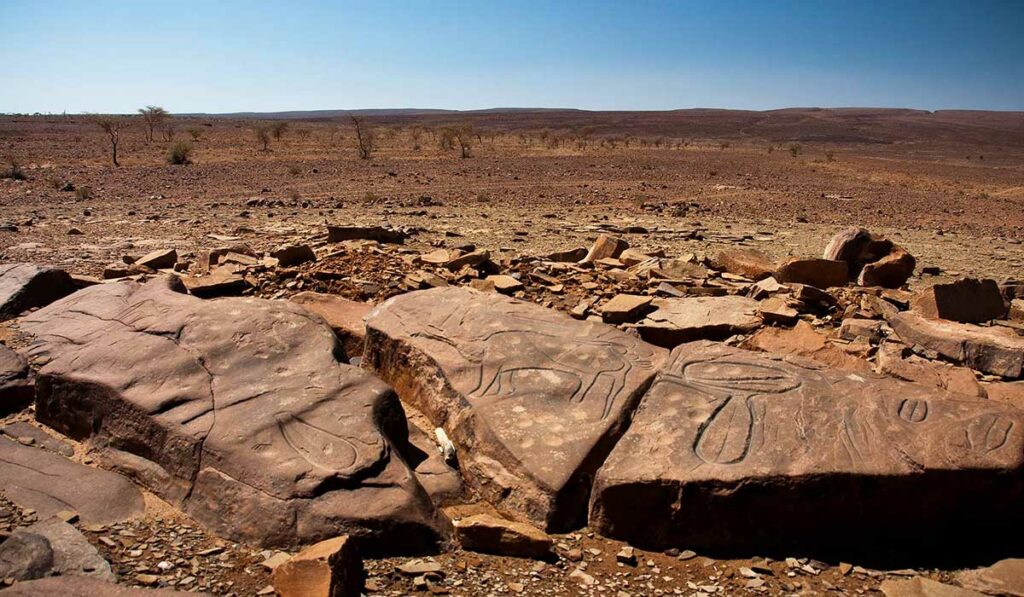
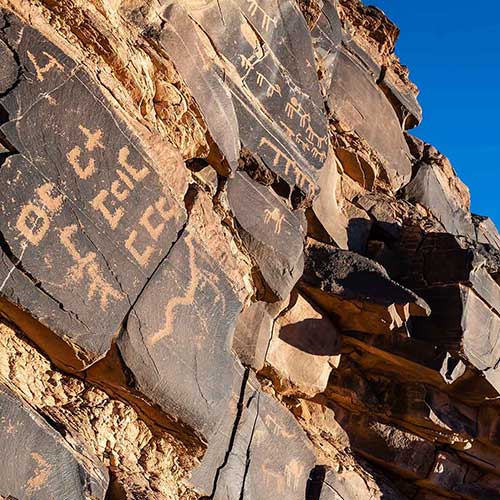
The term “rock art” (from the Latin “rupes” meaning rock) refers to all works of art created by humans on rocks, most often in open-air settings. It should not be confused with “parietal art” (from the Latin “parietalis” meaning related to walls), which encompasses works of art created on cave walls in interior settings.
The various rock engravings are not the work of a single community but rather of a succession of populations and cultures. The variety of themes and techniques used reflects gradual changes in the lifestyle, activities, and beliefs of these prehistoric populations.
Rock art developed over time and space, hence its richness and diversity.
Certain characteristics allow for a classification of engravings into four periods.
The first period, known as Bubaline Naturalistic, dates back to between 8000 and 7000 years BCE. It is distinguished by the representation of animal species with well-rendered proportions and details (such as large wild buffalo, elephant, rhinoceros, hippopotamus…).
The Bovidian period is characterized by an abundance of representations of cattle and corresponds to the appearance of domesticated cattle around 4000 years BCE.
The Libyco-Berber period covers the period between 3000 and 500 years BCE and is characterized by representations in dotted lines with the appearance of domesticated animals such as goats, dogs, horses, or camels. It is towards the end of this period that the first signs of writing appear, ancestors of the Tifinagh alphabet of the Tuaregs.
Long before the construction of the kasbahs in the Drâa Valley, its riverbanks were inhabited by prehistoric populations. The first observations of rock engravings date back to the 19th century. Sites are located all along the valley and in the foothills of the Jbel Bani. Thousands of rock engravings, displaying various styles and techniques, depict different stages of the evolution of this art, from the era of hunters to that of shepherds, through the ages of metals, and ending with protohistoric periods.
Thus, the Drâa Valley represents the most significant concentration of prehistoric art in Morocco.
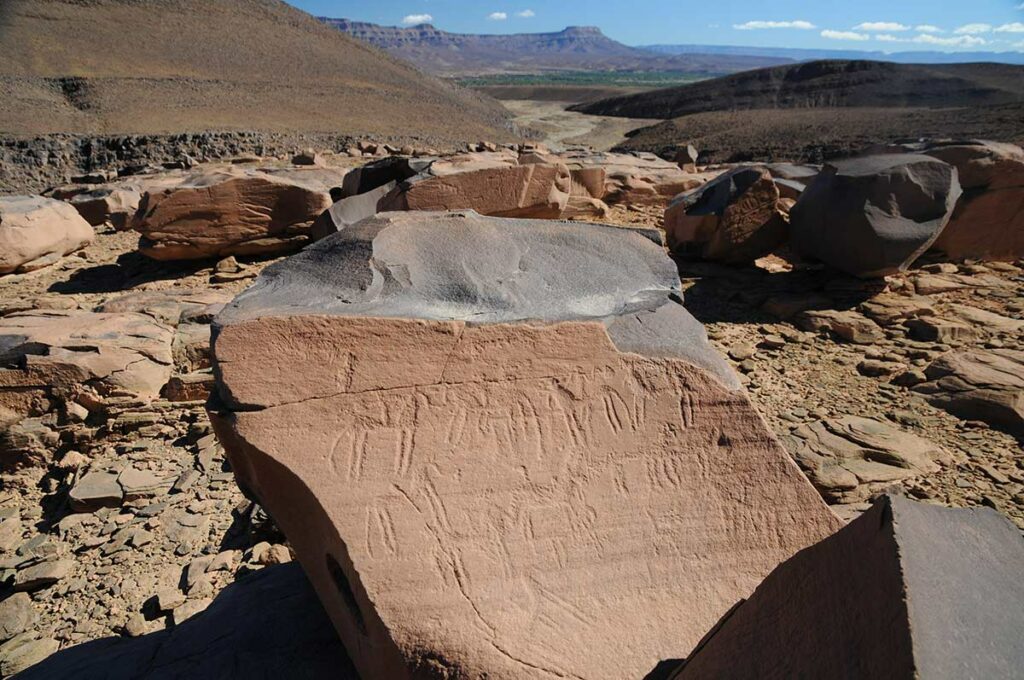
The site of Foum Chenna is the most significant in this region. It is located 11 km west of the village of Tinzouline, in the province of Zagora. This site is attributed to the Libyco-Berber period, featuring over 800 engravings depicting domestic animals (goats, dogs, camels…), wild animals (ostriches, mouflons, felines…), armed horsemen with shields and lances, scenes of combat, and ostrich hunting scenes.
In addition to these images, there are Libyco-Berber inscriptions, which actually represent the largest concentration of inscriptions known to date among all Moroccan rock art sites. These engravings overlap with older ones, characterized by black patina, blending with the rock. Thus, they indicate two distinct periods of use of this site.
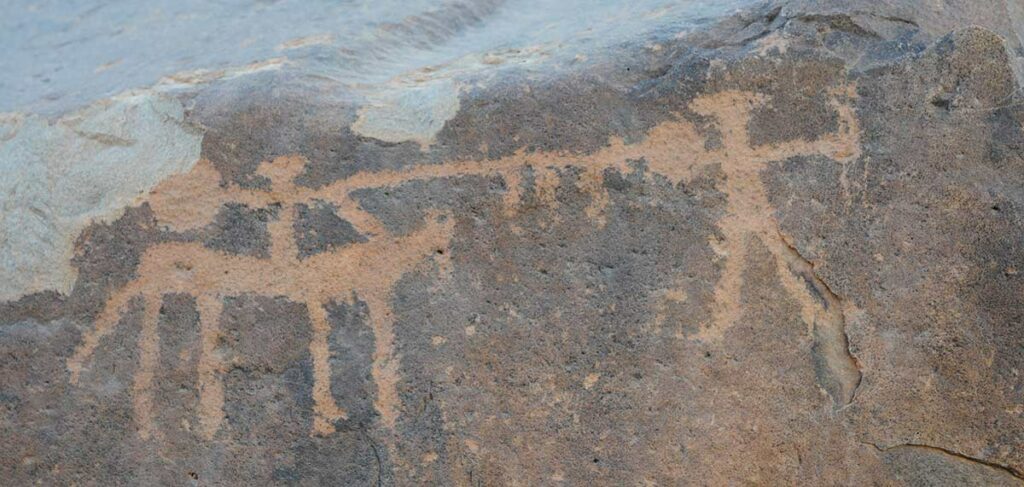
Two other sites of the same style and period are Assif Ouigane and Jorf Al Khil. The latter contains about a hundred engravings, mainly depicting horsemen, horseshoes, and figures of jewelry such as fibulas and small circles that could be interpreted as bracelets.
Morocco hosts rock engravings in other regions such as the plateaus of the High Atlas (Oukaïmeden, Yagour, and Rat), the desert areas of Es Smara and Saguia El Hamra, the surroundings of Layoune, and the sites of Tazarine and Tata.
The plateaus of the High Atlas are considered a major center of rock art in Morocco. With their elevation exceeding 2300 m, they remain the only known sites in North Africa at such a height. They feature engravings that provide rare evidence of the Bronze Age in Morocco, a period ranging from 3800 to 400 BCE.
The site of Oukaïmeden hosts over a thousand engravings depicting weapons (clubs, halberds, points, arrows, daggers, axes, and shields). In addition to these images, there is a rich and varied fauna represented (bovids, elephants, lions, snakes, etc.).
The Tazzarine region hosts around ten sites of rock engravings, such as the Aït Ouazik, Tiouririne, Abdi Bou Ilili, and Boukerbour sites.
These engravings are characterized by an abundance of depictions of wild animals (elephants, giraffes, ostriches, buffalo antelope, etc.), typical of a steppe environment. Geometric figures are also noticeable, including spirals, concentric arches, or radiating circles, interpreted as markers for hunting traps.
The Tata region includes sites such as Imaoun, Tiggane, Oum La Leg, and Adrar Metgourine, as well as sites in the Tamanart Valley such as Icht, Aguerd, Wazzazoun, and Taghjijt.
The Imaoun site, located 30 km north of Akka (Tata province), harbors impressive geometric engravings featuring concentric circles and spirals.
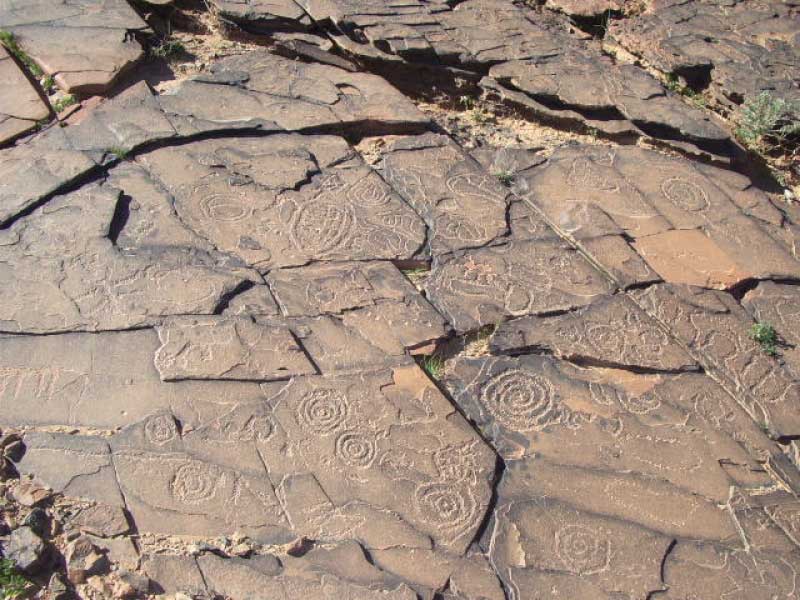
The rock engravings were created using two techniques: pecking and polishing. Often, both techniques were employed by the engravers of the time, with pecking work preceding the polishing of the line.
Pecking involves direct or indirect percussion (hammering) of the rock surface using a stone or metal tool. This technique results in irregular lines formed by a series of small cavities of varying depths.
Polishing is achieved through rubbing and back-and-forth motion along a previously pecked or incised line.
Furthermore, the engravings from that era have been affected by the passage of time on the rock surface. Over time, a patina has gradually formed, altering the original color by adding a shiny or matte film ranging in color from brown to black, or having a metallic appearance.
The color of the patina remains the sole criterion for estimating the age of an engraving and the only means to establish a chronology among engravings at a single site.
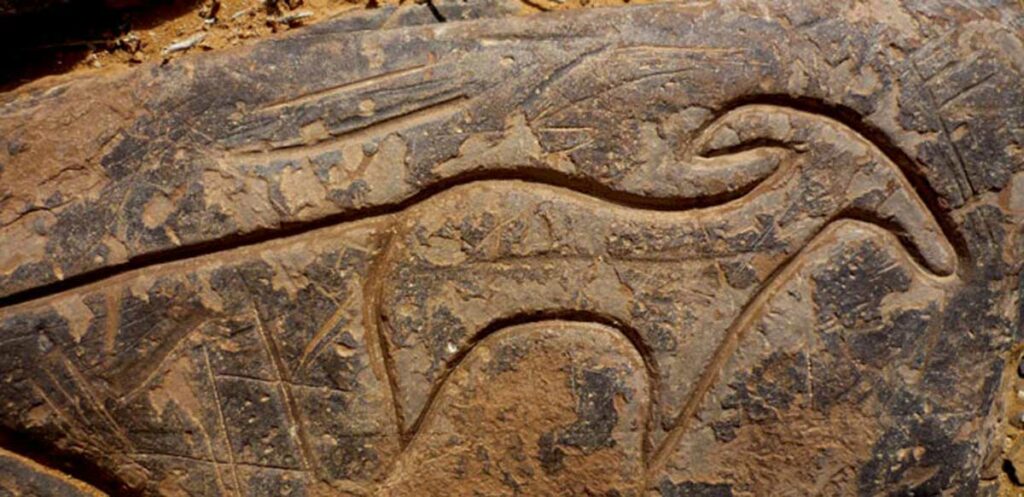
Rock engravings are legally recognized as cultural heritage of humanity at the international level. The archaeological sites in Morocco are protected by a law dated December 25, 1980. In 1994, the Ministry of Culture of Morocco established the National Center for Rock Art Heritage to ensure the safeguarding and preservation of this millennia-old heritage.
Southeast-morocco.com is the English version of the web magazine sudestmaroc.com.
© 2024 southeast-morocco.com. All rights reserved.